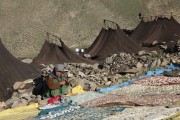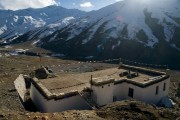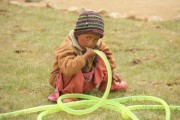Passive school building in the Himalayas
CVUT, the Faculty of Civil Engineering, has been participating in a very interesting project concerning a construction of "low of power" school in the Indian Himalayas in the Small Tibet. The school has been building in a village Kargyak, which is about 2-4 days of walking from the nearest place, which is accessible by car. Children from Kargyak and villages around (the nearest one is about an hour walk) have no opportunity to attend any school. In that fact, they are poor educated and they are not able to compete at the labor market with higher educated people from else where. And this is also one of the reasons, why Buddhism has been forced out by Islam religion. We got known about this project at the conference "Thermal Protection of Buildings 2006", where Doc. Kulhánek had a speech concerning the above mentioned topic and we, as "Energy Consultants", decided to support it. We have visited the place of construction and we consider financing this project in the future. A plan of the school is based on local realist conditions. The school is situated in an older monastery premises. On the left side of the Monastery there is a building under the construction, which will be a teacher's house (see pic.1). This place is advantageous, because it is located out of fields and farms and in addition there is the longest sun shine. Above the school there is possible to plant trees that grow up quickly. Just to give you an idea of the climate there - on September 2 2006 snowed. Typical buildings are made of adobe or stone. Roofs are flat, because there is minimum of rain and moreover it rains only during winter in form of snow. People use roofs to store firing for winter - sticks and dried excrements of herbivorous animals. For example: when we visited a local family for a dinner, the lady of the house prepared handmade "chapatee" - pancakes from water and flour. When she was putting on fire sticks, she had always washed her hands before she touched "chapatee". But when she was putting on fire the excrements, she had not washed her hands before she touched the pancakes - they are probably considered (perhaps by rights) as more hygienic than sticks which repose wherever. On pictures 3 and 4 there is shown the reality of local civil engineering, where you can see a woman carrying cricks from a place of production to a place of construction. It is interesting view on mixture of traditional technologies with new modern hi-tech technologies. Villages are far from each other and if you want to get from one to another you have to walk. There is also no electricity, the electricity is a problem in bigger towns too. For example, when we were in Leh, it happened that the electricity did not work for more than one day. Therefore, local people have their own photovoltaic cells, which can provide fatal gas/light. How it looks like, you can see on the picture 5, there are visible photovoltaic cells in a pile of excrements, behind which you can see adobe for future construction. On the pictures 6 and 7, you can see interior of a room, which is the living room (kind of our prior rooms in villages' houses). The constructions sources are set up by their prices and mainly by their ability. The village Kargyak is 74 km from the nearest place, where you can get by car. After driving you have to walk, but you must get from about 3500 meters above sea level to 4200 meters above sea level. Poor quality of roads is visible on the picture 8. Some parts of the roads are flat or among fields, but some of them are made from stairs hewed into rocks or bridges. To build up the school, the civil association SURYA has been arranging a civil collection, which was permitted by the municipal authorities of the Capital City Prague. We hope, that also readers of this server will support this project and contribute. If everyone contributed by a thousand crowns, it would be great, but of course smaller amounts are kindly appreciated. For these, who will be generous, will be prepared an excursion to India. Costs of the excursion are tax deductible. Your donation can be sent to a bank account of the ČSOB, account number: 208036504/0300 and you will be sent by a donation certificate, so it could be involved into your taxes calculation. Donators can be also mentioned on websites.

 In now days are hppening big changes in Jammu and Kashmir.
https://www.bbc.com/news/world/asia/india
In now days are hppening big changes in Jammu and Kashmir.
https://www.bbc.com/news/world/asia/india  On September 21st, Kargyak Sun School will celebrate the 10th anniversary of its opening. There, in one of the last places on Earth, the original Tibetan culture survives at the elevation of 4200 m. Before the school opened, the village of 200 heads had only 10 members who could read and write a little. To get an education, children were sent away to boarding schools in faraway towns. Today, the Sun School has its alumni and thanks to the project, people stopped moving away from the village.
On September 21st, Kargyak Sun School will celebrate the 10th anniversary of its opening. There, in one of the last places on Earth, the original Tibetan culture survives at the elevation of 4200 m. Before the school opened, the village of 200 heads had only 10 members who could read and write a little. To get an education, children were sent away to boarding schools in faraway towns. Today, the Sun School has its alumni and thanks to the project, people stopped moving away from the village.  PRAHA 22.11.2018 | 19:00 Betlémská kaple
BRNO 21.11.2018 | 19:00 Milosrdní bratři
PRAHA 22.11.2018 | 19:00 Betlémská kaple
BRNO 21.11.2018 | 19:00 Milosrdní bratři 


